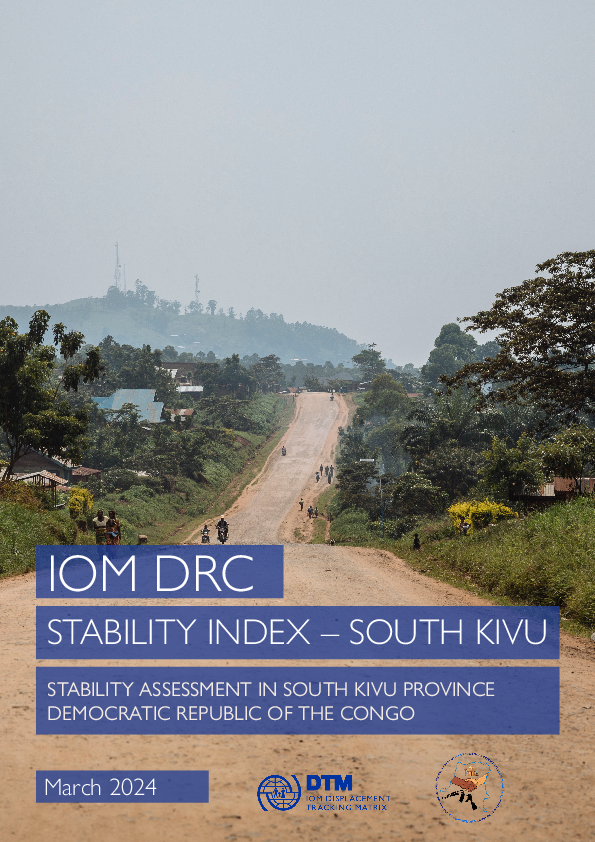-
Countries
-
Data and Analysis
-
Special Focus
-
Crisis Responses
DRC – Stability Index - South Kivu (March 2024)

Contact
DTM DRC, iomdrcdtm@iom.int
Language
English
Location
Democratic Republic of the Congo
Period Covered
Oct 22 2023
Nov 04 2023
Activity
- Survey
The province of South Kivu is home to the third largest IDP and returnee population of any province in the DRC (1.4 million and 690 thousand individuals respectively). While the province continues to experience conflict and armed group activity, particularly in light of the ongoing M23 (Mouvement du 23 mars) crisis in North Kivu, it has been the focus of recent efforts to strengthen durable solutions programming. DTM’s latest Mobility Tracking also reflects that 49 per cent of identified returnees in the province reporting security improvement as their principal reason for return (followed by food security improvement, family reunification and economic opportunities). South Kivu is also a target province for integration in the national program for disarmament, reintegration, and stabilization (Programme de Désarmement, Démobilisation, Rélevement Communautaire et Stabilisation – PDDRCS in French). Evidence-based guidance on durable solutions and stabilization programming is essential in South Kivu, considering the close proximity of areas experiencing continuing conflict and those in a more post-crisis context.
It is in this context that the International Organization for Migration (IOM), through the Displacement Tracking Matrix (DTM), has chosen to implement the Stability Index (SI) for the first time in the DRC with the aim of identifying “pockets of stability” for targeted durable solutions programming, as well as hotspots of relative instability, with a concentration of poor and unstable living conditions, more suitable to receive humanitarian assistance. In South Kivu, DTM implemented the SI in the territories of Fizi, Kalehe and Uvira, which together host 65 per cent of all returnees in the province.
The SI assesses the relative stability of a location by evaluating three key domains: 1) Livelihoods and access to basic services, 2) Safety and Security and 3) Social cohesion, as well as information pertaining to the occurrence and impact of natural disasters, analysed separately. The SI is part of the DTM’s global Solutions and Mobility Toolkit and has been deployed successfully in diverse contexts such as Burundi, the countries of the Lake Chad basin, Ghana and Mali.
325 Villages in the territories of Fizi (118 villages), Uvira (99), and Kalehe (108) were selected for inclusion in the analysis using simple random sampling from the DTM DRC village master list, updated during the twice-yearly Mobility Tracking exercise. In the DRC, the health zone is considered the third administrative subdivision (admin-3) below territory (admin-2). As some of the villages were inaccessible due to insecurity and/or weather conditions, while others were previously de-populated, only accessible villages with population present at the time of the data collection were assessed. Due to the sampling design, data are representative at a territory level. Despite analysis and presentation of the data in this report at the health zone level, the results are representative only at the territory level), with 95 per cent confidence and a five per cent margin of error. Stability Index exercise was implemented in partnership with national non-governmental organization Réseau d’Action pour le Développement et le Progrès Intégré (RADPI) and Division Provinciale des Affaires Humanitaires (DIVAH).
Mean stability varied substantially among assessed territories (Admin 2). It was highest in Uvira and lowest in Kalehe.
Among the three territories assessed, Kalehe was found to be relatively less stable, with an average Stability Index score of 56 (out of 100), compared to Fizi (67) and Uvira (71).
